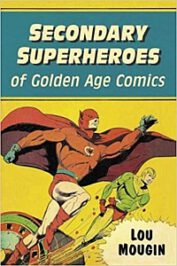Even with comic book superheroes, there have been the fortunate ones, the famous gang and then, the “others,” in this case describing the many clones or rather, imitators of the likes of Superman or Bat-Man (as he originally was named in the golden age).
As it should be clear that in the Golden Age of Comics (roughly the years from the late 1930s to the mid-1950s) not just Marvel or DC were popular, but many, many other publishers also wanted to sell copy.
 Then, copyright claims were rather rare when it came to superheroes who to a great extent reminded the reader of a successful character from another series by another publisher at the average American newsstand. So if the new character had a very similar name and wore a very similar spandex, it would not raise too many eyebrows, as at that time the “borrowing” of creative ideas in comics was not uncommon.
Then, copyright claims were rather rare when it came to superheroes who to a great extent reminded the reader of a successful character from another series by another publisher at the average American newsstand. So if the new character had a very similar name and wore a very similar spandex, it would not raise too many eyebrows, as at that time the “borrowing” of creative ideas in comics was not uncommon.
There seemed to be an infinite number of “B” characters or, as the author suggests, “secondary” superheroes around. Many of them disappeared, leaving no more trace than perhaps one or two issues or a guest appearance in another, equally soon to be terminated comic book line. Other characters survived on beaten copies, impossibly rare, resurfacing maybe on microfiche somewhere.
They are mostly forgotten and many “… superheroes and jungle lords and ladies and spacemen and adventurers of that time have just not been covered in the same depth and with the same attention to detail.”
Hardly anybody today will remember the comic book publishers Prize, Centaur, Holyoke, Columbia, Ace, Chesler or Street and Smith.
Or some of their superheroes such as the Black Cat, Golden Lad, Magno, the Black Dwarf, Saber, the Black Terror, Atoman, Professor Supermind, Crimebuster, Cat-Man, the Flag, Princess Moon Girl, the Hooded Detective or the Blue Beetle.
Some reasons for their disappearance probably were the comparatively low quality, unimpressive adventures or weak plots of the editions. Furthermore, many publishers dropped their avengers and switched to other lines, as Westerns, romance stories or war comics.
A major problem for many, however, became the uproar of the many American organizations that fought comic books. “The Wertham anti-comics crusade of the late Forties/early Fifties, triggered by the increasing depravity of crime and horror comics, dealt the death blow to a lot of smaller publishers and caused the survivors to adopt an in-house censorship board, the Comics Code Authority, which toned down Comics considerably.”
The book at hand tells their stories, and the author is aware that he supplies tons of information to add to comic book history with it, where the secondary line of performers usually is rather neglected.
Mougin’s approach throughout the book is organized mainly by publisher and their sometimes huge stable of superheroes. Usually, each character is introduced, analyzed and his adventures throughout all traceable copies are presented.
This is very intriguing, as more than a few avengers would receive a complete and spontaneous makeover in any new edition, something that would alter their names, their legends, outfits and sometimes even their abilities. Mostly, of course, to model their personality and looks closer to that of a superhero from another publisher who sold better. Details on the artists, publishers and writers are mostly very concise; at the center, we find the superheroes and their (sometimes brief) development instead.
Regarding the number of superhero films available at the moment, maybe a future movie featuring one of the forgotten characters mentioned here might be of interest to the big studios and audiences looking for fresh stories.
In that situation, Secondary Superheroes of Golden Age Comics would be one place to get inspiration from. The over-sized paperback comes with 104+ photos and a large index. It is very unlikely that more than a hand full of experts around will know all the characters unearthed here.
Lou Mougin is a popular comics writer and historian from Texas.
Review by Dr. A. Ebert © 2020
Lou Mougin. Secondary Superheroes of Golden Age Comics. McFarland, 2019, 446 p.
